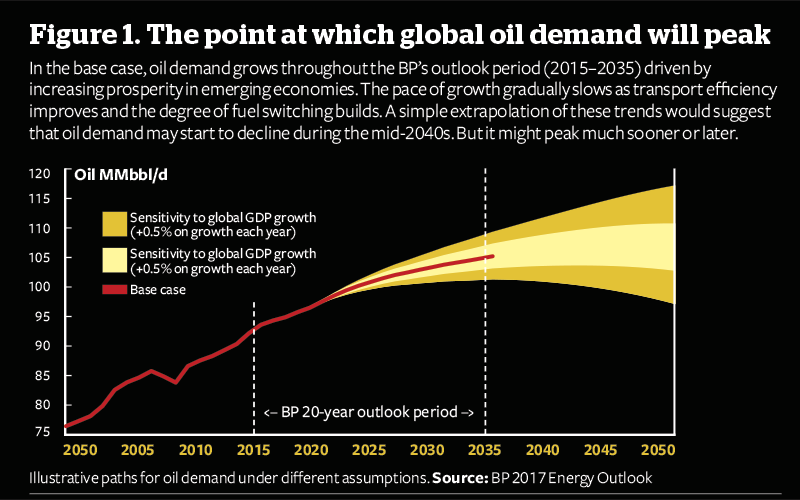Special report: Evolving in the new energy era
Nicholas Newman looks at how companies are adopting more creative strategies and more flexible business models to grow in a new dynamic energy market.

Until very recently, governments and oil companies feared the prospect of peak oil, a time of expensive and declining supplies. Recent exploration and production advances delayed peak oil until the mid-century but, in a rapid turn-around, the industry now faces ‘the prospect of peak demand’, according to Jon Clark, UK and Europe, Middle East, India and Africa Leader, Oil and Gas Transactions at EY – a view which has subsequently gained widespread credence.
Peak demand, a time when demand for oil significantly slows and begins to fall, is expected to arrive between the early 2020s to mid-2040s (Figure 1), depending upon the speed of energy efficiency savings, adoption of electric vehicles, renewables and the switch from oil to gas in power generation.

Already, oil companies have diversified into natural gas, unconventional shale and renewables such as wind and solar, for example, Shell bought BG, to acquire its expertise in natural gas and liquefied natural gas. Shell has also diversified into renewables and has just announced that it will begin to supply electricity to its forecourts and industrial customers in the UK. Italian oil giant, Eni, has reduced oil exploration in favour of gas and made spectacular finds off the coasts of Egypt and Mozambique. Likewise, French energy giant Total has begun to supply renewable energy to customers. Acquisition, as a means of market entry into other sources of energy, is expected to increase as companies plan for peak demand. However, the logical strategy, of harvest and exit has so far only been implemented by DONG Energy, which announced its exit from oil in favour of renewable energy production and distribution.
As oil fields reach the end of their useful life, especially in the North Sea, Alberta in Canada and Texas, companies are beginning to consider what to do with their redundant infrastructure. ‘At present, there are two main options being discussed – removal and leave in place,’ says Paul Jardine, CEO of Quatre Ltd, a provider of exit strategy management solutions to the oil industry. Currently, regulations favour the removal of oil and gas infrastructure from depleted fields. A case in point is the North Sea, where UKCS decommissioning expenditure could reach up to £2bn per year with a total of £17bn expected to be spent by 2025. While the oil majors have set aside funds for this eventuality, smaller companies face financial, engineering and logistical challenges in dealing with redundant infrastructure.
How utilities are changing
The power sector is also operating in a changing environment brought on by market liberalisation, tougher environmental regulations and the rise of, increasingly price competitive new sources of fuel. For example, in the UK, energy utilities such as SSE, RWE and E.ON were regional suppliers of electricity and gas. Market reforms introduced competition for customers across the country. In response, utilities have introduced innovative value added services for industrial and commercial electricity customers. For example, E.ON provides an extensive range of new business energy management services including, managing on-site generation, and heating ventilation and air-conditioning operations for industrial and commercial building’s customers.
In the UK, the US, Mexico and Europe, natural gas and renewables are increasingly replacing coal or expensive oil or diesel in power generation. Utility companies are therefore investing in gas peaking plants to maintain electricity supplies when neither wind nor sun are available. Moreover, utility companies face losing an increasing number of high energy consuming customers, such as BMW, IKEA and Google as they switch solely to clean energy, thus opening the way for new entrants such as Shell and Good Energy to provide renewable energy and green gas.
For utilities, there is a positive aspect, a new market opportunity presented by the predicted electric car revolution. In essence, utilities could benefit handsomely from the rise in demand for electricity from this new market.
Corporate culture is changing
Many of the major oil companies have been around a long time. ExxonMobil was founded in 1882, Royal Dutch Shell in 1907 and BP in 1908. In addition, with longevity came a corporate culture focused on economic expansion by augmenting reserves and getting as much oil out as quickly as possible and at any cost. The price crash of 2014 has inaugurated significant changes. Cost cutting, efficiency drives and industrialisation by standardisation and modularisation, have displaced bespoke equipment and tailored approaches to exploration and field development. The oil and gas industry, a relative IT laggard, has adopted Internet of Things technologies which connect equipment and use sensors to communicate with augmented-reality tablets as well as supervisors.
Conventional oil and gas has traditionally been characterised by high capital expenditure, long-time scales and centralised decision-making. Companies including BP, Chevron and ExxonMobil that have entered unconventional oil and gas exploration, particularly in the rich Permian Basin, have devolved decision making to units on the ground. This is a response to the completely different business model of unconventional energy production. The typical conventional oil and gas project has costs reaching up to US$50bn and takes decades. In contrast, a shale gas or oil well costs up to US$6m and takes about six months from drill to product. This requires speedy decision making by subsidiaries on the ground.
It wasn't so long ago that energy companies faced expanding demand for their product and fossil fuels predominated. However, new sources of fuel, a price collapse and potentially big changes in the ratio of supply and demand will test companies like never before.






Follow us
Advertise
Free e-Newsletter